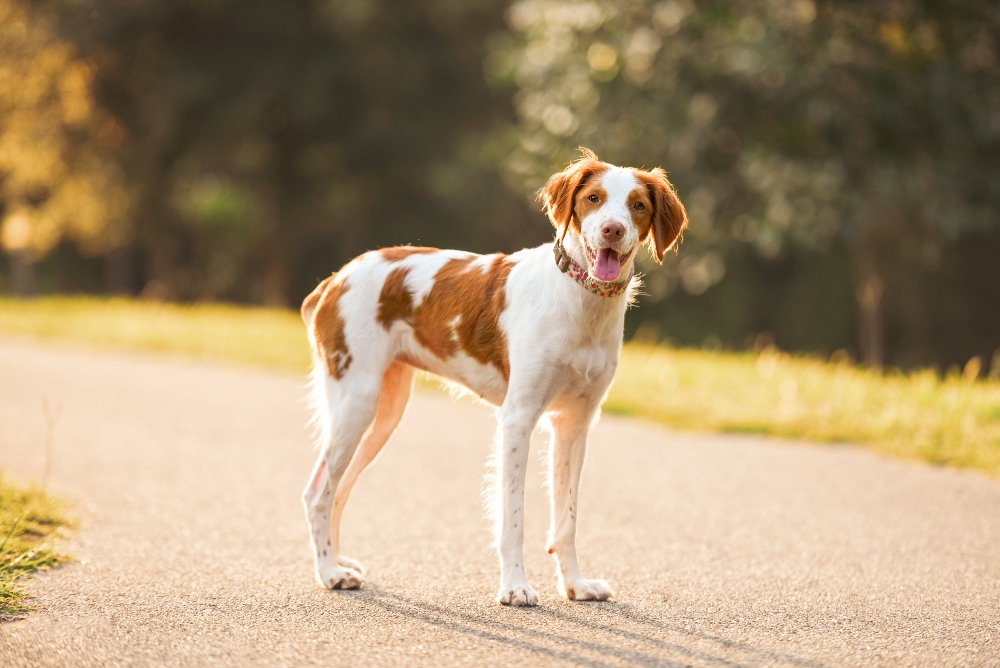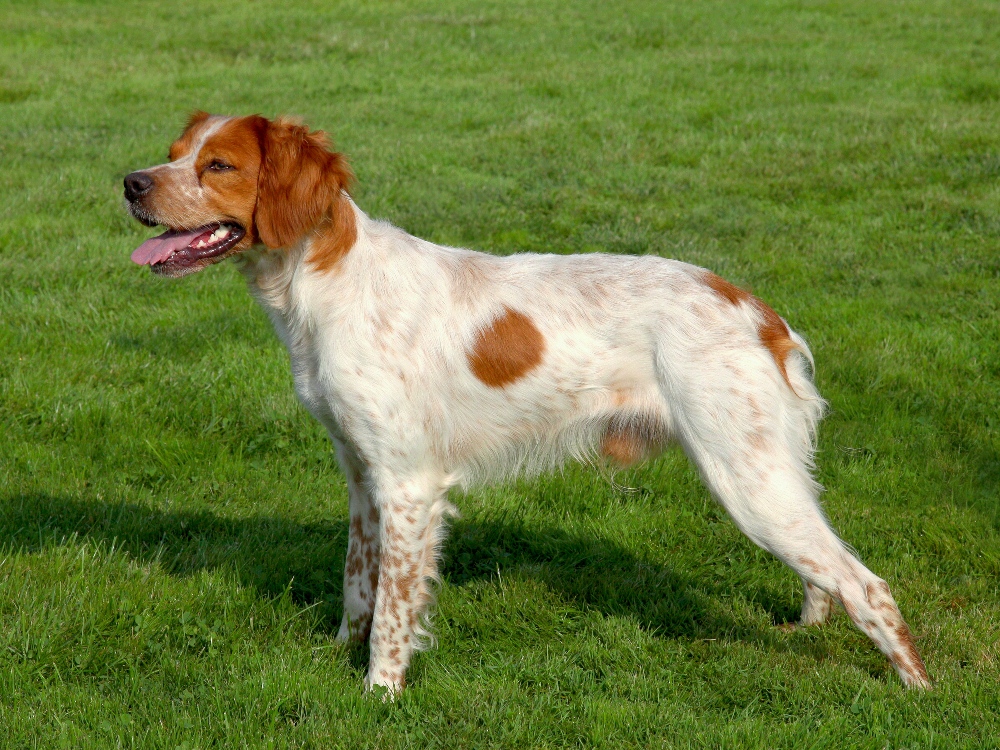Table of Contents
Introduction to Brittany Spaniels
Brittany spaniels have fun-loving and upbeat personalities that make them a true joy to have around the house and in your life. These agile and versatile dogs are smaller than setters and have beautiful coats that come in white, orange, and reddish-brown colors. Brittany spaniels excel in sports training and are very trainable for hunting and simple playtime activities. Active and outdoorsy families love Brittany spaniels because of their high energy and all-around friendliness.
If you are thinking about adopting or purchasing a Brittany spaniel, here are some things to know about the breed and how to take the best care of your new dog at any age.
Size of Brittany Spaniels
When a Brittany spaniel is fully grown, you can expect the dog to weigh about 30 to 40 pounds and stand at about 17.5 to 20.5 inches tall. Although many of these dogs are done growing by 12 months, others may continue to get a little larger until 16 months of age. The size differences between male and female Brittany spaniels are minimal, and these dogs are considered to be of medium size.
Here’s how big you can expect your Brittany spaniel to get when fully grown.
| Weight Chart | 3 months | 6 months | 9 months | 12 months | 16 months |
| Male and Female Brittany Spaniels | 13-16 lbs. | 23-30 lbs. | 27-35 lbs. | 30-28 lbs. | 30-40 lbs. |
Characteristics of Brittany Spaniels
Both families and sportsmen adore Brittany spaniels because of their versatility. However, these dogs have a high energy level that isn’t the right fit for everyone. They are enthusiastic dogs that have a true joy for life and can be challenging to keep up with if you aren’t in good shape! Brittany spaniels are task-oriented and love having a job to do, but they can be sensitive to harsh words and actions, so always be sure to treat your dog with love and respect.
As you get to know a Brittany spaniel’s personality, here’s what you can expect based on his or her breed characteristics:
| Breed Characteristic | Level (High, Medium, Low) |
| Affectionate with People | High |
| Good with Kids | Medium |
| Good with Pets | High |
| Need for Exercise | High |
| Energy Level | High |
| Intelligence Level | High |
| Able to Be Trained | Medium |
| Amount of Barking | Medium |
| Amount of Shedding | Medium |
History of Brittany Spaniels

The Brittany spaniel is named after the Brittany region in western France, which is next to the English Channel and the Bay of Biscay. French hunters developed the breed to be versatile bird dogs that could hunt ducks, pheasants, partridges, and other types of birds. Brittany spaniels have been featured in 17th century paintings and were very common in Europe during this time period in history.
The Brittany spaniel breed came to the U.S. in the 1930s, and the American Kennel Club registered its first Brittany spaniel dog in 1934. The AKC shortened the name of the breed to just Brittany in 1982 after the American and French lines diverged and Brittanys in the U.S. began having more in common with pointers. Still today, Brittany spaniels are used as field hunting dogs and successfully compete in dog shows.
Brittany Spaniel Standard Information
Brittany spaniels are unique in that they have long legs and light bones. This helps these dogs be very quick on their feet and cover a lot of ground with their movement. These are athletic, eager, and alert dogs that are bred to have heavy eyebrows for eye protection and a square proportion. Brittany spaniels have a rugged movement style and are excellent at covering ground in a vigorous way because of the way they have been bred over the years.
Here is an overview of the breed standard information for Brittany spaniels:
Head:
- Eager and alert with a soft expression
- Well-set eyes in heat with expressive eyebrows
- Short and triangular ears
- Medium length and rounded skull
- Medium length muzzle that tapers gradually
- Fawn, tan, brown, or pink nose (not black)
Neck, Topline, Body:
- Medium length neck, free from throatiness
- Deep chest reaching level of the elbow
- Tail not too long to affect the dog’s balance
Forequarters:
- Shoulder blades not too wide apart
- Pasterns slightly sloped
- Leg bones clean and graceful
- Feet hallway between the hare and cat foot-style
- Dewclaws may be removed
Hindquarters:
- Broad, strong, and muscular hindquarters
- Thighs well feathered, not profusely
- Hocks moderately short but not pointing in or out
Coat:
- Wavy, flat, and dense coat
- Not curly, wiry, or silky
- Ears with little fringe
- Some feathering on front and hind legs
Color:
- Orange and white or liver and white with clear or roan patterns
- Some ticking is desirable
- Tri-colors are allowed but not preferred
Gait:
- Hind foot should step into or beyond print from the front foot while trotting
- Clean movements
- Smooth, efficient, and ground-covering side gait

Caring for Brittany Spaniels
Brittany spaniels live an active lifestyle and do well with a large yard or even acres of land where they can run around. They are not ideal for apartment living unless a family spends a lot of time outside and exercising the dog. These dogs love wide-open spaces and thrive with a little freedom. But you’ll need to teach them to come back when called and keep your Brittany spaniel occupied mentally and physically to prevent destructive behavior.
Here are some general tips for taking the best care of a Brittany spaniels:
Best Living Environments:
- Home with a large yard
- Open acreage, such as a farm
- Not ideal for apartment living
- Don’t leave dogs alone for long periods of time
- Supervise children around dogs (may be too rambunctious for younger children)
Type of Exercise:
- Hiking with family members
- Running around in a yard or open space
- Hunting activities
- Sports and agility training
Mental Enrichment:
- Puzzles and stimulating games to exercise the mind
- Agility and obedience activities for a challenge
Training Strategies:
- Do not use harsh words or actions with these sensitive dogs
- Be consistent and playful with training
- Train dogs to do sports for physical and mental stimulation
Grooming Tips:
- Generally easy to groom with weekly brushing
- Only occasional baths or use dry shampoo between baths
- Not excessive shedders
- Trim nails once or twice per month
Common Health Problems of Brittany Spaniels
Something good to know about Brittany spaniels is that these dogs are part of a very healthy breed that has minimal health concerns. The average life expectancy for a Brittany spaniel is 12 to 14 years. The national breed club for this type of dog recommends that breeders have parents tested with a hip evaluation and ophthalmologist evaluation to screen for possible genetic issues.
These are some of the most common health issues that arise with Brittany spaniels:
- Epilepsy
- Hip dysplasia
- Hypothyroidism
- Elbow dysplasia
- Eye diseases
Diet and Nutrition for Brittany Spaniels
Brittany spaniels need about 1.5 to 2 cups of dry dog food each day, divided into two meals. Some recommended types of commercial dog food for Brittany spaniels are Royal Canin Medium Adult Dry Dog Food, Purina Pro Plan Sport All Life Stages Performance Dry Dog Food, Hill’s Science Diet Dry Dog Food, and Iams ProActive Health Adult MiniChunks Dry Dog Food.. Brittany spaniels are prone to having sensitive stomachs, so you may need to try a few different dog food brands before finding one that agrees with your furry friend’s digestive system.

Where to Adopt or Purchase Brittany Spaniels
The American Brittany Club, Inc. is a breed-specific club that was founded in 1942 and offers resources for breeders and education. There are also many rescue groups that specialize in helping these Brittany spaniels get adopted, such as the National Brittany Rescue and Adoption Network (NBRAN), American Brittany Rescue, the Brittany Foundation, and the Independent Brittany Rescue and Rehabilitation. Depending on where you get your Brittany spaniel from, the cost of adoption could be around $100, while purchasing a Brittany spaniel from a reputable breeder might cost more like $500 to $1,100.
Related Breeds
If you like what you have been learning so far about Brittany spaniels and think this might be the right dog for you, it might also be fun to learn about similar and related breeds of dogs. Here are some dogs that share common characteristics with the Brittany spaniel:
- English pointer
- German wirehaired pointer
- German shorthaired pointer
- Clumber spaniel
- English springer spaniel
- Boykin spaniel
- Deutscher wachtelhund
Pet Insurance for Brittany Spaniels
To be prepared for whatever comes your Brittany spaniel’s way, it is a smart idea to enroll your dog in a pet insurance plan from Healthy Paws at an early age. Our pet insurance plans allow you to take your Britany spaniel to any licensed vet and covers everything from emergency care to genetic conditions, vet specialists, and alternative care.
To get started, request a Brittany spaniel pet insurance quote today and enjoy peace of mind that you’ll never have to make a difficult decision between finances and taking the best care of your canine companion.









